dormakaba USA SDC2K Single Door Controller User Manual UserGuide 2 1 01 28 08 part A
Stanley Security Solutions, Inc. Single Door Controller UserGuide 2 1 01 28 08 part A
Contents
- 1. user manual
- 2. user manual 2nd part
- 3. Manual 1
- 4. Manual 2
- 5. Manual 3
user manual
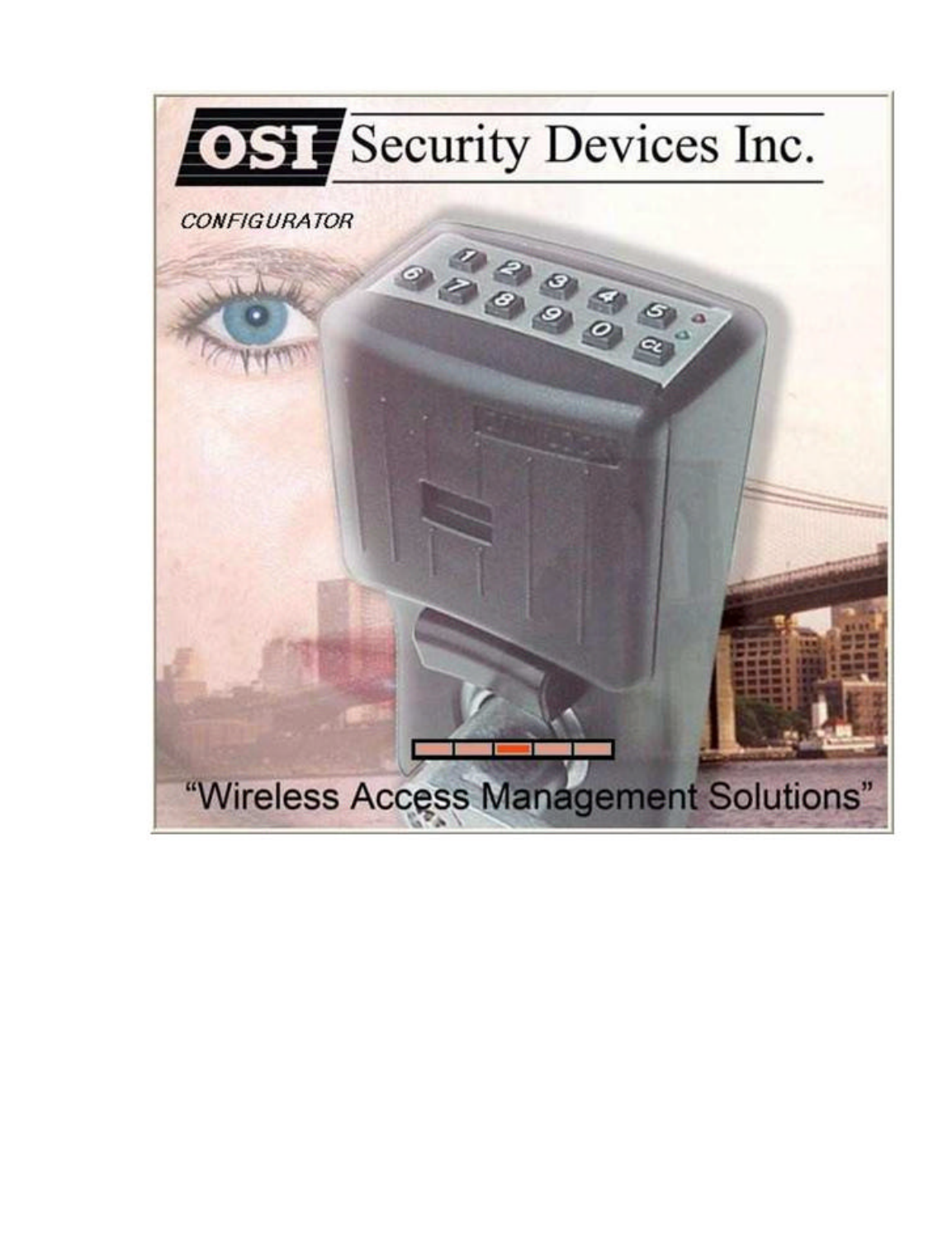
USER’S GUIDE
Version 2.0
1/29/2008
WIRELESS ACCESS MANAGEMENT SYSTEM

ii - USER’S GUIDE
OSI SECURITY DEVICES, INC
1580 Jayken Way
Chula Vista, Ca. 91911-4644
Phone: (619) 628-1000
Fax: (619) 628-1001
E-mail: sales@omnilock.com
Website: http://www.omnilock.com/
OSI Portal Gateways have been approved for use under FCC ID T8H-PG16, and IC: 6498A-
PG16. Operation is subject to conditional use. “This device complies with Part 15 of the FCC
Rules. Operation is subject to the followoing two conditions: (1) this device may not cause
harmful interference, and (2) this device must accept any interference received, including
interference that may cause undesired operation.”
©2008 OSI Security Devices, Inc. All rights reserved.
OMNILOCK is a Registered Trademark of OSI Security Devices, Inc.
Microsoft, Windows, Windows XP, and Secure Socket Layer (SSL) are registered trademarks of
Microsoft Corporation. All other Trademarks used or referenced in this document are the property of
their respective owners.
WIRELESS ACCESS MANAGEMENT SYSTEM

USER’S GUIDE - 3
Contents
FCC Certification .................................................................................................................5
SOFTWARE OVERVIEW .......................................................................................................5
WAMS Users ................................................................................................................... ..6
User Types... ................................................................................................................ ..6
USING WAMS CONFIGURATOR ........................................................................................ ...7
Launching WAMS Configurator ............................................................................................7
Display Options ..................................................................................................................8
Tab Options .......................................................................................................................8
Facility Tab.................................................................................................................... ..8
Readers Tab ................................................................................................................ ..9
Timezones Tab ........................................................................................................... ..10
Users Tab ................................................................................................................... .10
Adding Users to the Facility ............................................................................................. ..10
Before You Begin ........................................................................................................ ..11
Users Tab Overview .......................................................................................................12
ID..................................................................................................................................13
Name ......................................................................................................................... ..13
User Defined Fields ...................................................................................................... .13
Associations ................................................................................................................ .13
Credential Settings..........................................................................................................15
Settings ...................................................................................................................... ..21
Reader Control...............................................................................................................22
USING WAMS TRANSACTIONS........................................................................................ ..23
WAMS Transactions Overview ... ........................................................................................23
Reader and Portal Controls ........................................................................................... .23
Transactions Tab ........................................................................................................ ..23
Alarms Tab....................................................................................................................24
Transaction Types ........................................................................................................... .25
Organizing and Sorting Transactions ................................................................................ ..25
Display by Timespan.......................................................................................................25
Sort by Column Header ................................................................................................ .26
View Transactions in Tree Levels ... ............................................................................... .26
Responding to Alarms ...................................................................................................... .27
WAMS Statistics Monitor................................................................................................... .29
USING WAMS REPORTS ................................................................................................... .29
Reports Overview ........................................................................................................... ..29
Creating Reports in WAMS .............................................................................................. ..29
Configure Report Settings ...............................................................................................30
Generating a Report .......................................................................................................31
Generating Larger Reports .......................................................................................... ..33
Printing and Exporting Reports ..................................................................................... ..33
Using Dialup Networking................................................................................................... .35
Using WAMS System Administrator ....................................................................................35
WIRELESS ACCESS MANAGEMENT SYSTEM

4 - USER’S GUIDE
WIRELESS ACCESS MAN AGEMENT SYSTEM

USER’S GUIDE- 5
FCC Certification
This equipment has been tested and found to comply with the limits for Class B Digital Device,
pursuant to Part 15 of the FCC Rules. These limits are designed to provide reasonable
protection against harmful interference in a residential installation. This equipment generates and
can radiate radio frequency energy and, if not installed and used in accordance with the
instructions, may cause harmful interference to radio communications. However, there is no
guarantee that interference will not occur in a particular installation. If this equipment does cause
harmful interference to radio or television reception, which can be determined by turning the
equipment off and on, you can try to correct the interference by taking one or more of the
following measures.
• Reorient or relocate the receiving antenna
• Increase the separation between the equipment and receiver
• Connect the equipment into an outlet on a circuit different from that to which the receiver
is connected
• Consult the dealer or an experienced radio/TV technician for help.
This device has been designed to operate with a maximum gain of 2.2 dBi. Approved antennas are
listed below. Antennas not included in this list or having a gain greater than 2.2dBi are strictly
prohibited for use with this device. The required antenna impedance is 50 ohms. The EUT is not
designed for or intended to be used in portable applications (within 20 cm of the body of the user)
and such uses are strictly prohibited. To ensure that the device complies with current FCC
regulations limiting both maximum RF output power and human exposure to radio frequency
radiation, a separation distance of at least 20 cm must be maintained between the unit's antenna
and the body of the user and any nearby persons at all times and in all applications and uses and
must not be co-located or operating in conjunction with any other antenna or transmitter.
Approved Antennas
• Portal Gateway :
Antenna Factor ANT-2.4-CW -RCT-xx
• Reader:
Integrated Antenna
• Single Door Controller:
Antenna Factor ANT-2.4-CW -RCT-xx
IMPORTANT! Any changes or modifications not expressly approved by the party responsible for
compliance could void the user’s authority to operate the equipment.
SOFTWARE OVERVIEW
The OSI Wireless Access Management Solution (WAMS) provides powerful tools to manage your
system: WAMS Configurator, WAMS Transactions, WAMS Statistics Monitor. View and print
reports from WAMS Configurator and WAMS Transactions using WAMS Reports.
If you are the Program Administrator responsible for setting up communications between WAMS
software and system portals and readers; you will spend most of your time using WAMS
Configurator. If you are in personnel or security, you may be the person who adds users to the
system and gives them access priviliges and IDs. You will spend most of your time on the Users
tab of the WAMS Configurator. If you are responsible to oversee security for your organization, you
will monitor all access and alarm activity using WAMS Transactions. If you are the person
responsible to ensure the system is operating at maximum performance, you will use the WAMS
Statistics Monitor. If your organization is small, you may use all three!
WIRELESS ACCESS MANAGEMENT SYSTEM
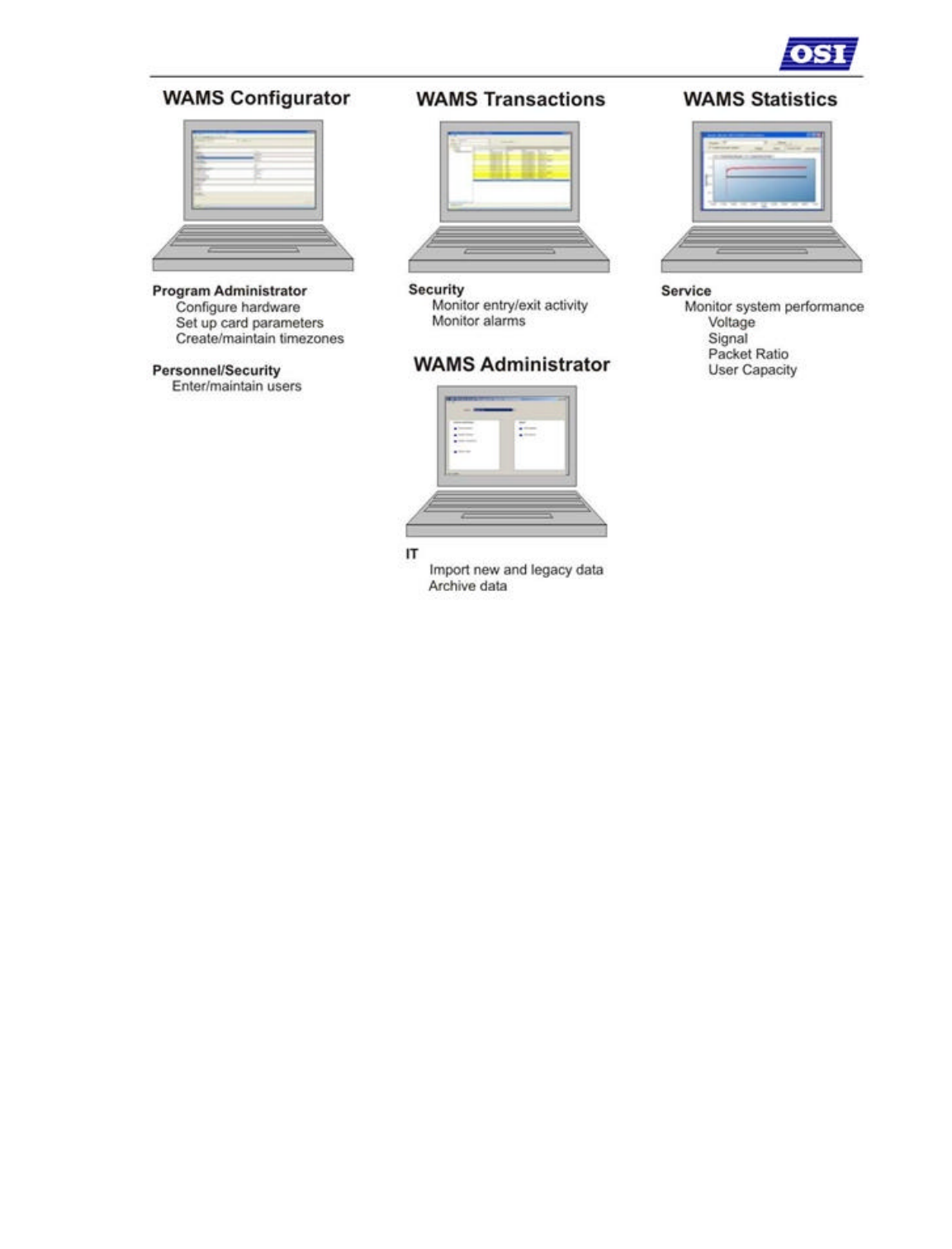
6 - USER’S GUIDE
Once the software is installed, you will find the WAMS Configurator shortcut on your desktop.
You can access all applicaltions from the WAMS Configurator main menu. You can also access
these applications from the Windows Start Menu.
WAMS Users
WAMS Users, as opposed to reader users, are those individuals who will operate one or all of
WAMS software applications. For example, a WAMS User might be a person in the Security
department who will use only WAMS Transaction software to monitor system access activity.
Another WAMS User might be a person in Human Resources or Administration who is assigned to
add users to the system, or change their settings.
Most WAMS users will be added to the system as reader users because they will have some type
of physical access to the facility, but they must also be assigned as WAMS Users and be given
Usernames and Passwords if they are to access and operate WAMS application software.
User Types
WAMS Users can be one of four User Types: Administrator, Manager, Service, and General.
You will be assigned a User Type depending on which WAMS applications you will log in to and
operate.
Administrator - An Administrator has access to all WAMS applications and all facilities. This
User Type would be assigned to a System Administrator, that is, someone who is responsible for
set up and configuration.
Manager - Can access all WAMS applications. This type would, for example, be assigned to
someone responsible for adding users to the system. As an additional security measure, this
type could be restricted to access specific facilities only.
WIRELESS ACCESS MANAGEMENT SYSTEM
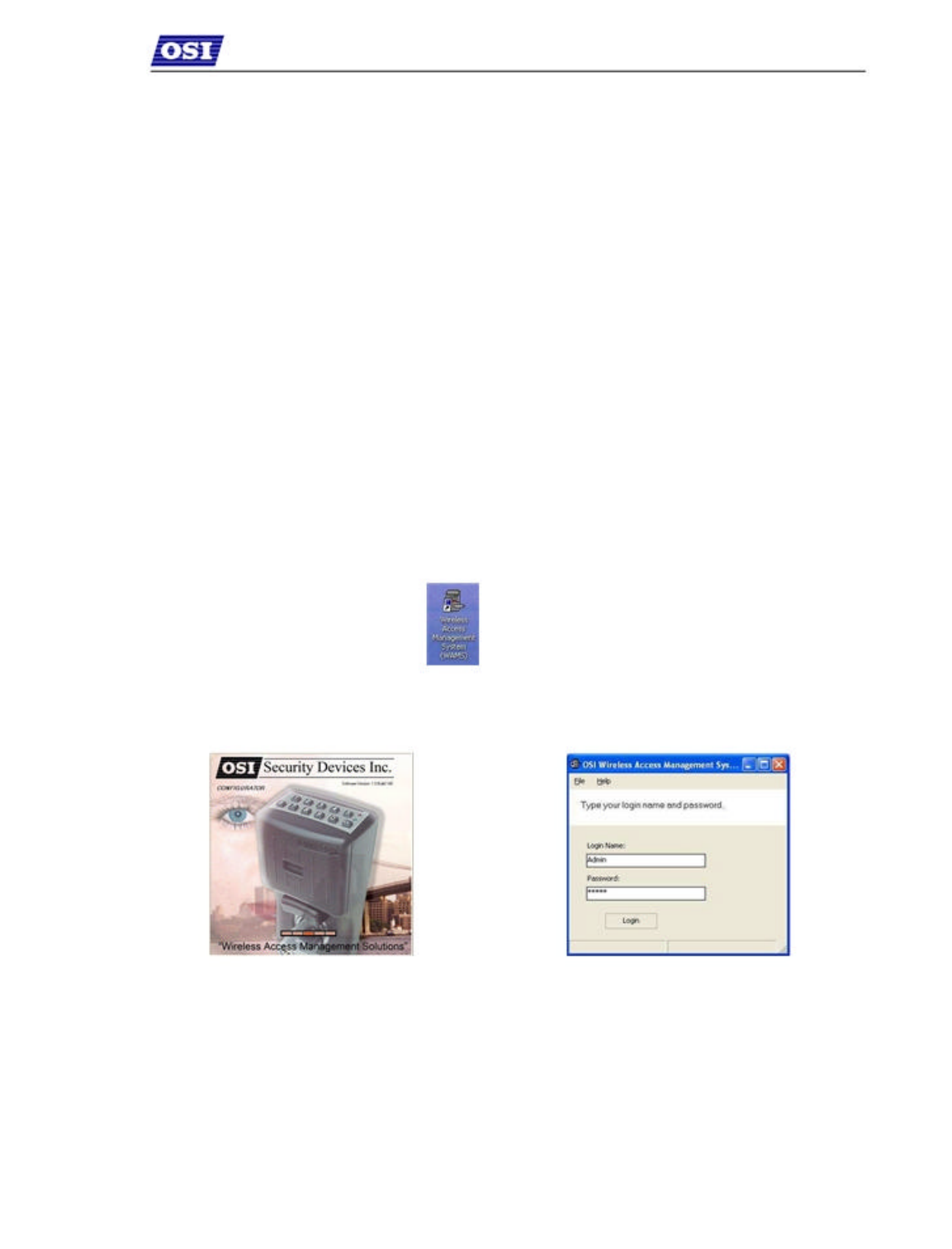
USER’S GUIDE- 7
Service - Can access WAMS Transactions and WAMS Statistics Monitor. This User Type can
also be restricted to specific facilities only, if needed.
General - Can access only the WAMS Transactions and WAMS Reports applications for specific
facilities. This user type would be assigned to someone in Security for example, who will monitor
daily entry and exit activity and system alarms. They can not access the WAMS Configurator
application.
Once an Administrator has logged in to the system, they can add WAMS Users to the system. If
you are designated as a WAMS User, you will be assigned a login User Name and Password to
access the Software Application(s) you need.
USING WAMS CONFIGURATOR
If you are in Human Resources, Personnel, or Security; you may be the person who adds users to
the system and gives them access priviliges and IDs. You will spend most of your time on the
Users tab of the WAMS Configurator. The following sections describe how to launch WAMS
Configurator, provide a brief overview of the WAMS Display and Tab options.
Launching WAMS Configurator
When WAMS software is loaded onto your computer, it places a shortcut to WAMS on your
desktop.
Double-click the WAMS Configurator icon to start the application.
The OSI WAMS splash screen appears briefly, then the Login dialog box opens.
If you are a WAMS User, your System Administrator or IT representative must provide you a
Login Name and Password. You will need this to login the WAMS Configurator. If you are a
System Administrator, see the Administrator’s Guide for more information about Launching
WAMS for the first time.
To Login to the WAMS Configurator:
1. Enter your case-sensitive Login Name and Password.
2. Select Login. WAMS Configurator opens at the Reader Tab.
WIRELESS ACCESS MANAGEMENT SYSTEM
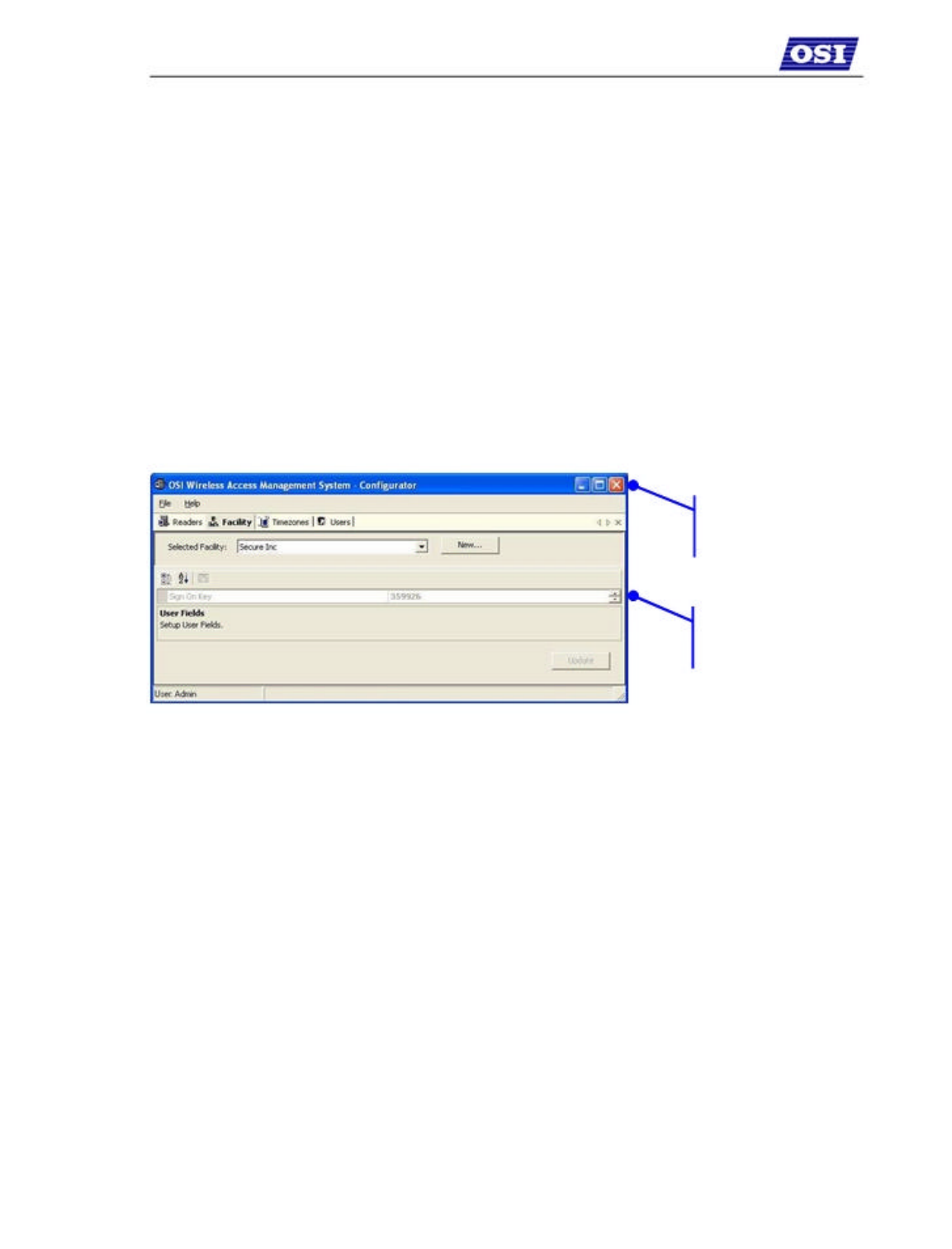
8 - USER’S GUIDE
If the System Administrator has created only one facility, you are ready to begin. If more than
one facility has been created, select the facility from the drop-down list. Any elements you
access in WAMS Configurator will be directed to that facility.
IMPORTANT: Once the System login and password have been personalized for your facility, it is
important to record the information in hard copy form and safeguard it in a location known to
management.
Display Options
All tasks in WAMS start from the WAMS Configurator, which has four tabs: Readers, Facility,
Timezones, and Users. Following is a brief description of WAMS display options and how the tabs
are used to perform tasks. WAMS operates in the Windows environment using its standard
conventions. You can use WAMS full screen or resize the window using the min/max buttons in the
top right corner of the Configurator.
In minimized view, use the up or down arrows to select from a list of categories or options.
Following is the Facility Tab in minimized view with the scroll bar visible.
Minimize,
maximize, and
close.
Up and down
arrows
In the Facility and Users Tabs you can display items by category or sort alphabetically. This is
useful when displaying the Configurator in full-screen view.
Tab Options
The WAMS Configurator contains four tabs: Readers, Facility, Timezones, and Users. You will
select these tabs depending on which program tasks you wish to perform.
If your Program Administrator has created more than one facility, you will need to select the
facility you wish to work with from the Facility Tab before moving on to add or maintain users
assigned to that facility. Following is a quick tour of the WAMS Configurator tabs.
Facility Tab
Most Facility set up tasks are performed in the Facility Tab. Here, the Program Administrator will
create User Groups, Timezones, and configure WAMS software to work with the type of facility
access cards or keypad credentials you will use.
If your Program Administrator has created more than one facility, you will first select the facility
you wish to work with in the Facility Tab before moving on to add or maintain users assigned to
that facility.
Following is the Facility Tab displayed in full-screen, category view. Once you select a category,
you can drill down to additional settings using the ellipsis button.
WIRELESS ACCESS MANAGEMENT SYSTEM
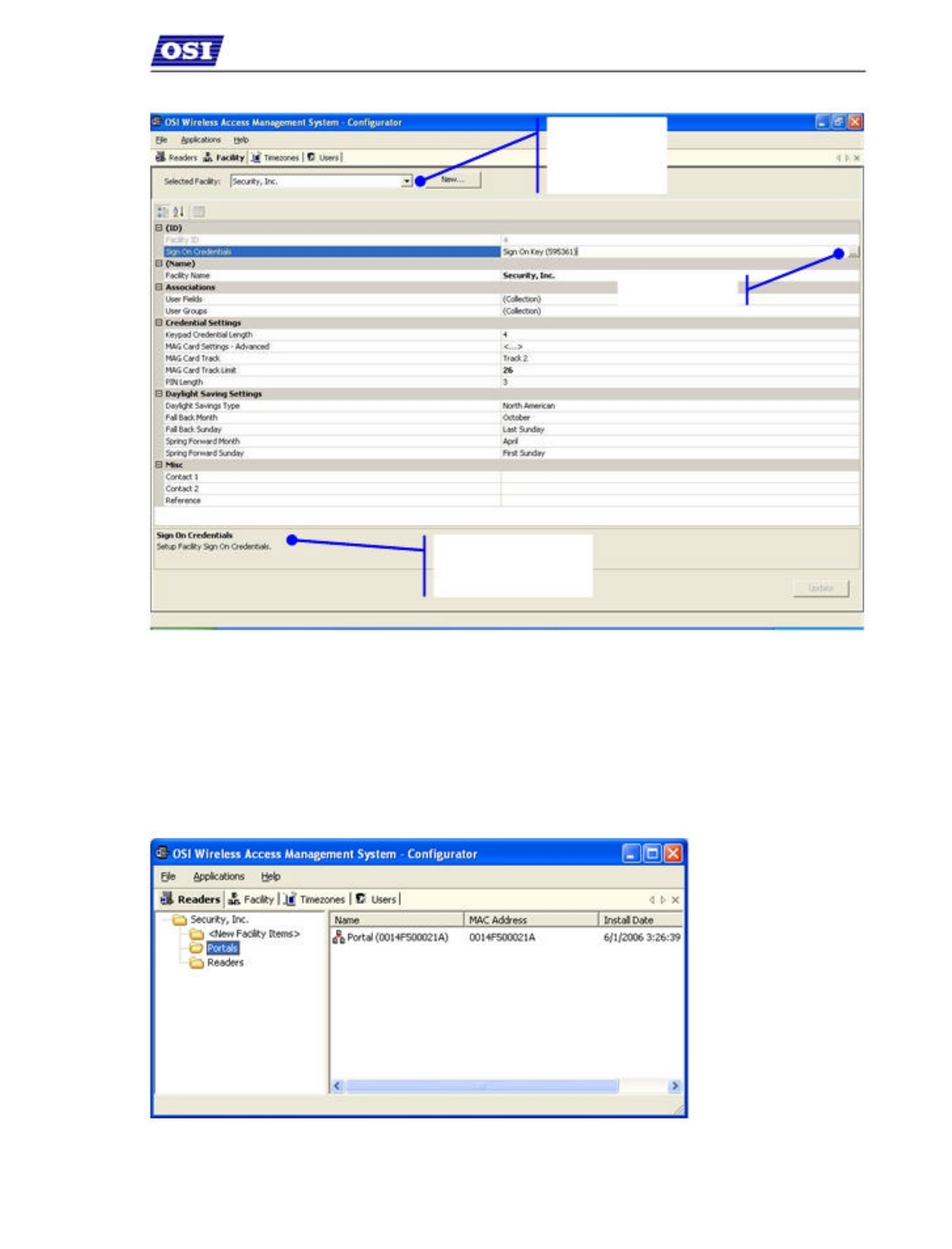
USER’S GUIDE- 9
Use the drop-
down list to
select a facility
to work with.
Ellipsis Button
Displays brief
description of the field
selected above.
Readers Tab
The Readers tab displays the Facility Tree, which is a visual representation of all portal gateways,
readers, and I/O devices connected to the WAMS software. Once the devices are organized in
the Facility Tree, the various paths to associate readers and portals are available when you add
new users to the system. If you are using dialup gateway modems in your system, you can
perform an automatic dial out from here. Information about creating the Facility Tree and
assigning devices to the various folders in the tree is presented in the Administrator’s Guide.
Typically, only the Program Administrator will perform tasks using the Readers Tab.
WIRELESS ACCESS MANAGEMENT SYSTEM
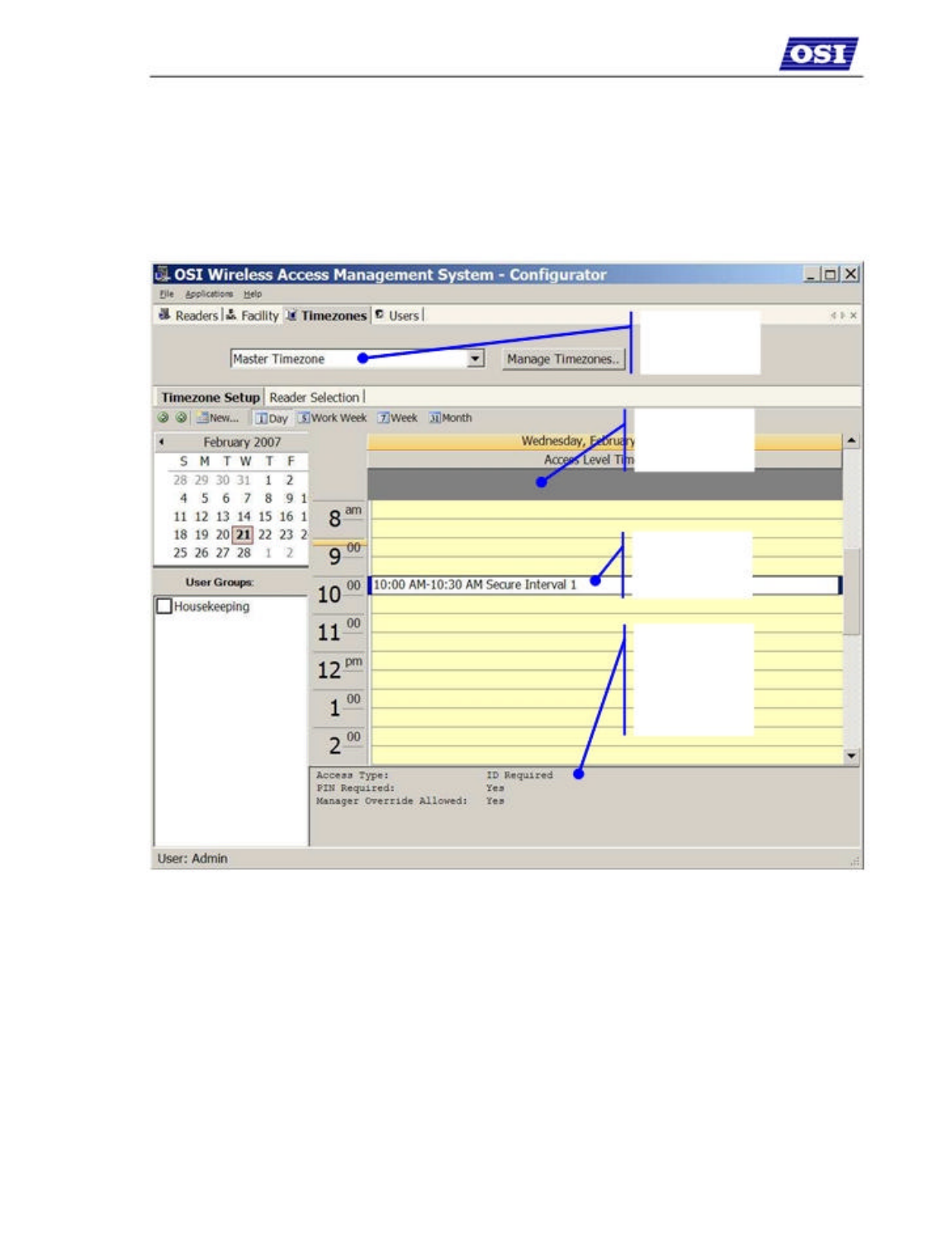
10 - USER’S GUIDE
Timezones Tab
The WAMS program automatically assigns all readers to a Master Timezone. Your Program
Administrator can create any number of Timezone Intervals and Timezone Groups to modify user
access within the Master Timezone. The Timezones tab displays the default Master Timezone, a
calendar that operates similar to Microsoft Outlook, and any Timezone User Groups that have
been created. (For more information about creating Timezone Intervals and Timezone Groups, see
the Administrator’s Guide.)
Default: Master
Timezone
Calendar Detail
Defined
Timezone
Interval
Message Field
displays the
access
parameters set
for the selected
Timezone
Users Tab
If you have been assigned responsibility to add users to the system, your tasks will be performed in
the Users Tab. This tab is described in detail in the following section.
Adding Users to the Facility
Once all hardware and software have been configured, the system is ready for you to add users to
it. Follow the steps in this section the first time you enter users, and each time you add a new user
to the system.
To get started, launch WAMS Configurator. The program opens at the Facility Tab. If your
organization has been configured with more than one facility, select the facility you want to work
with, then select the Users Tab.
WIRELESS ACCESS MANAGEMENT SYSTEM
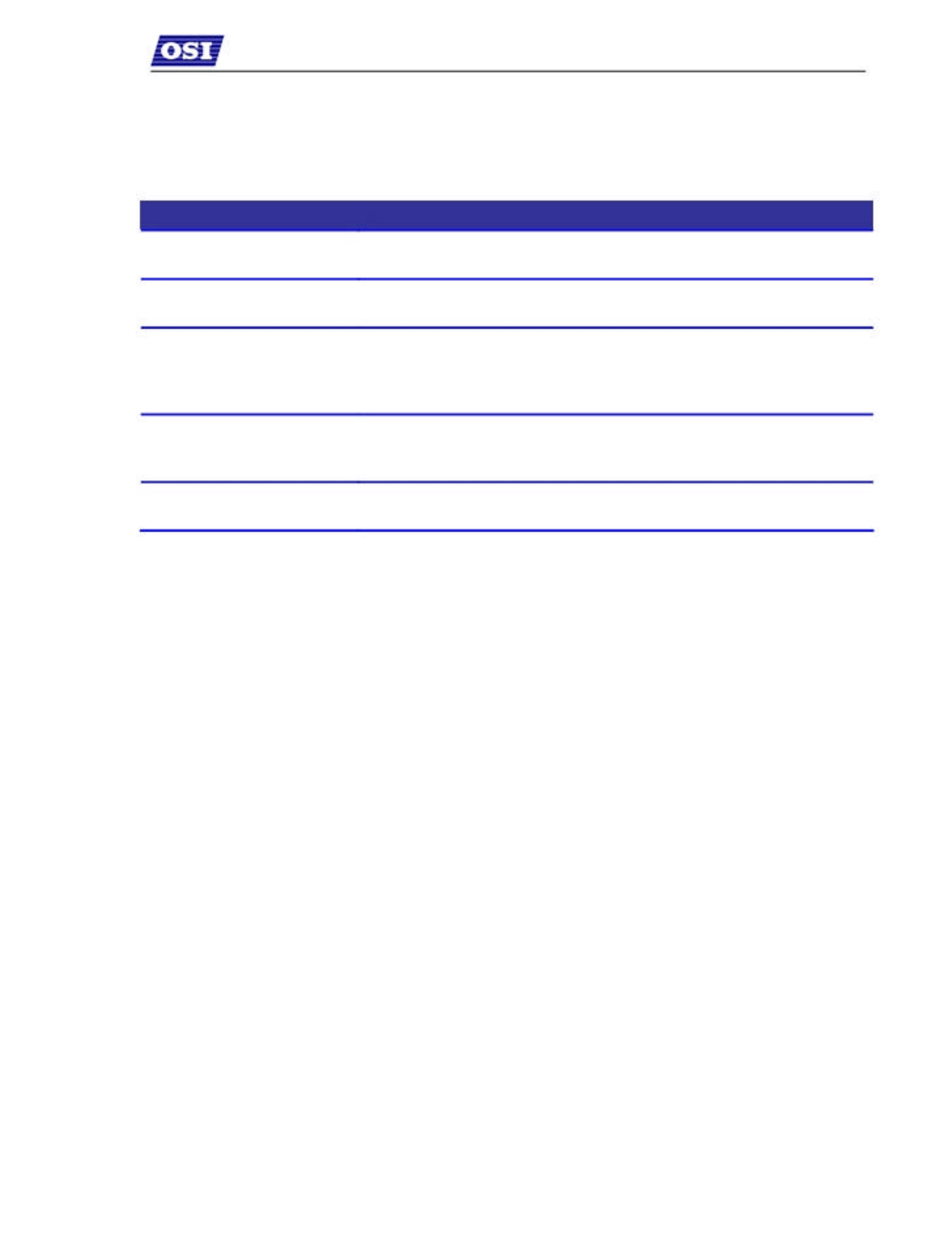
USER’S GUIDE- 11
Before You Begin
Before you begin adding users to the system for the first time, be prepared to address the
following items:
IF
_
You plan to use
only
keypad readers
_
You plan to use
card
readers
_
You plan to use a
serial
scanning device at your
computer to register user
credentials
_
You plan to use
local
readers to register
credentials
_
You plan to manually
enter
the credential numbers
THEN
WAMS assigns a unique keypad credential number to each new user and
automatically registers it with the system.
You must know the card type and settings required for that type.
The scanning device must be attached to the computer com port and you must be
able to identify that port (Com1, Com 2) when you register the credential.
Know the reader name and locations to be used.
Have a credential number list or creating conventions ready to enter.
NOTE: If you do not have this information, contact your System Administrator before you
continue.
WIRELESS ACCESS MANAGEMENT SYSTEM
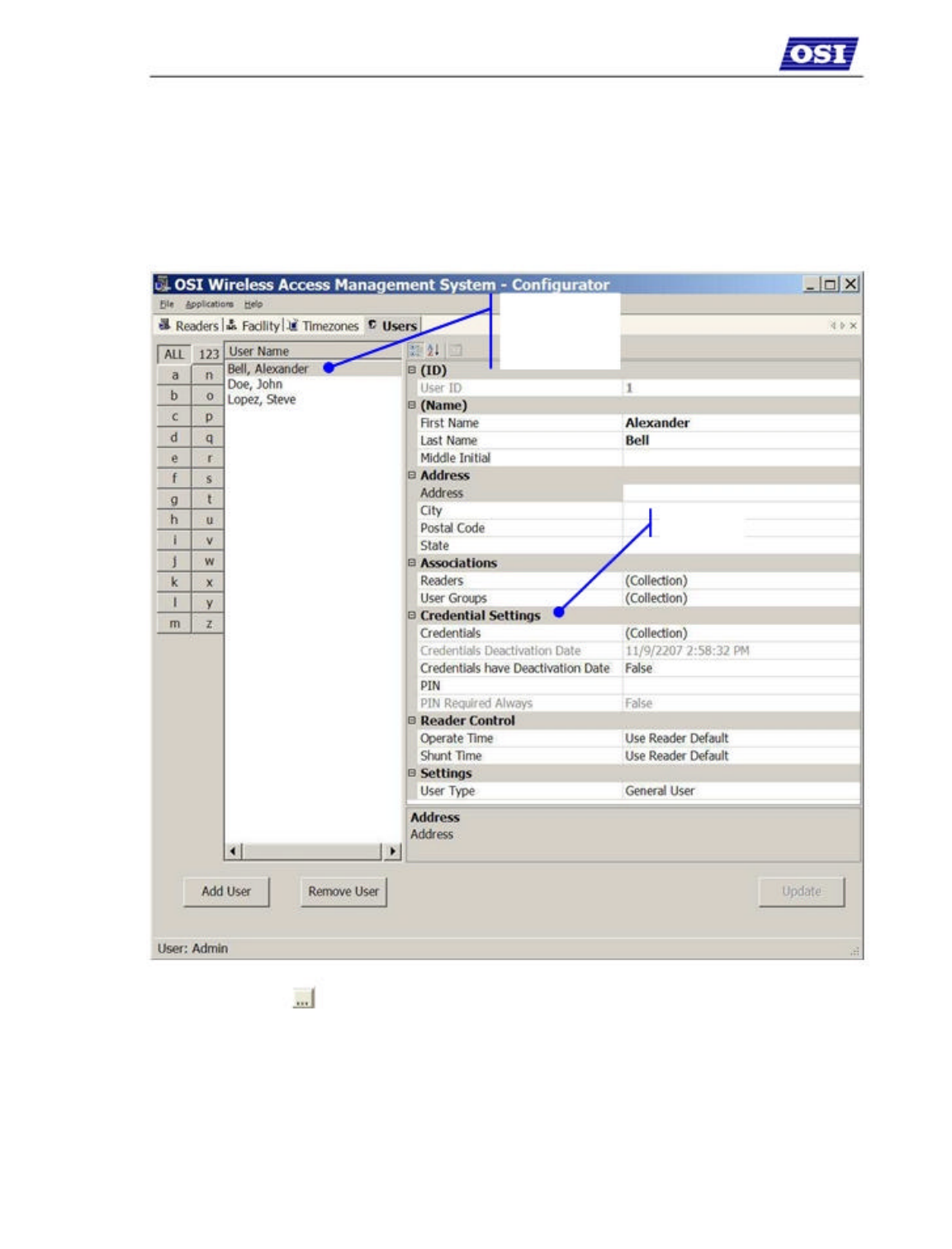
12 - USER’S GUIDE
Users Tab Overview
In the Users Tab, all users currently in the system display in the list on the left. If you have a
large number of users, you can use the alphabet buttons on the far left to sort through the list
quickly. User Categories display on the right. By default, these categories display as shown;
however you can click the A-Z sort button to display categories alphabetically. Here you can add or
remover users from the system, set their credentials, and include any personal information needed
to identify that person in the system.
Click to sort
categories
alphabetically
Category
If an ellipsis button displays when you select a field, additional parameters are available for
selection. From here you will define user name and address information and access parameters
such as readers, user groups, credentials, PIN, and so on.
NOTE: If you see a need for additional fields to define for your Users, contact your System
Administrator. They can add more fields to the Users Tab, or create additional User Fields
unique to your organization.
The following sections provide a brief description of each category in the Users Tab, and present
steps for adding and configuring users in the system.
WIRELESS ACCESS MANAGEMENT SYSTEM

USER’S GUIDE- 13
ID
When you add a user, the system automatically assigns them a unique ID and displays the
number in the User ID field.
Name
Provides entry fields for user first and last name and middle initial.
To add a user name:
1. In the Users Tab of the WAMS Configurator, select the Add User button. In the ID
category, the system will display a new unique User ID.
2. In the First Name line, place the cursor in the space following <New> and enter a first
name.
3. In the Last Name line, place the cursor in the space following <User> and enter a last
name. Do the same for the Middle Initial.
NOTE: The Update button will flash to remind you to update your settings. You can update each
time you add a user, or wait until all user information is added. The software will automatically
update your settings when you leave the Users tab.
User Defined Fields
If your facility has been configured with User Defined Fields, such as Address, City, Zip Code,
enter the information as configured.
Associations
In this category, you associate users with Readers and User Groups. This task defines which
readers will recognize the user’s requests for entry and exit. If User Groups have been created
for your organization, these will also be available for selection from the Associations category.
Readers
When you add a user to the system, you will associate them with the reader(s) that will recognize
their requests for entry and exit.
To associate a user with readers:
1. In the Associations category, Readers line, place the cursor next to (collection).
2. Select the ellipsis button at the right of the field. The View and Select Readers
Associated with User dialog box opens.
WIRELESS ACCESS MANAGEMENT SYSTEM
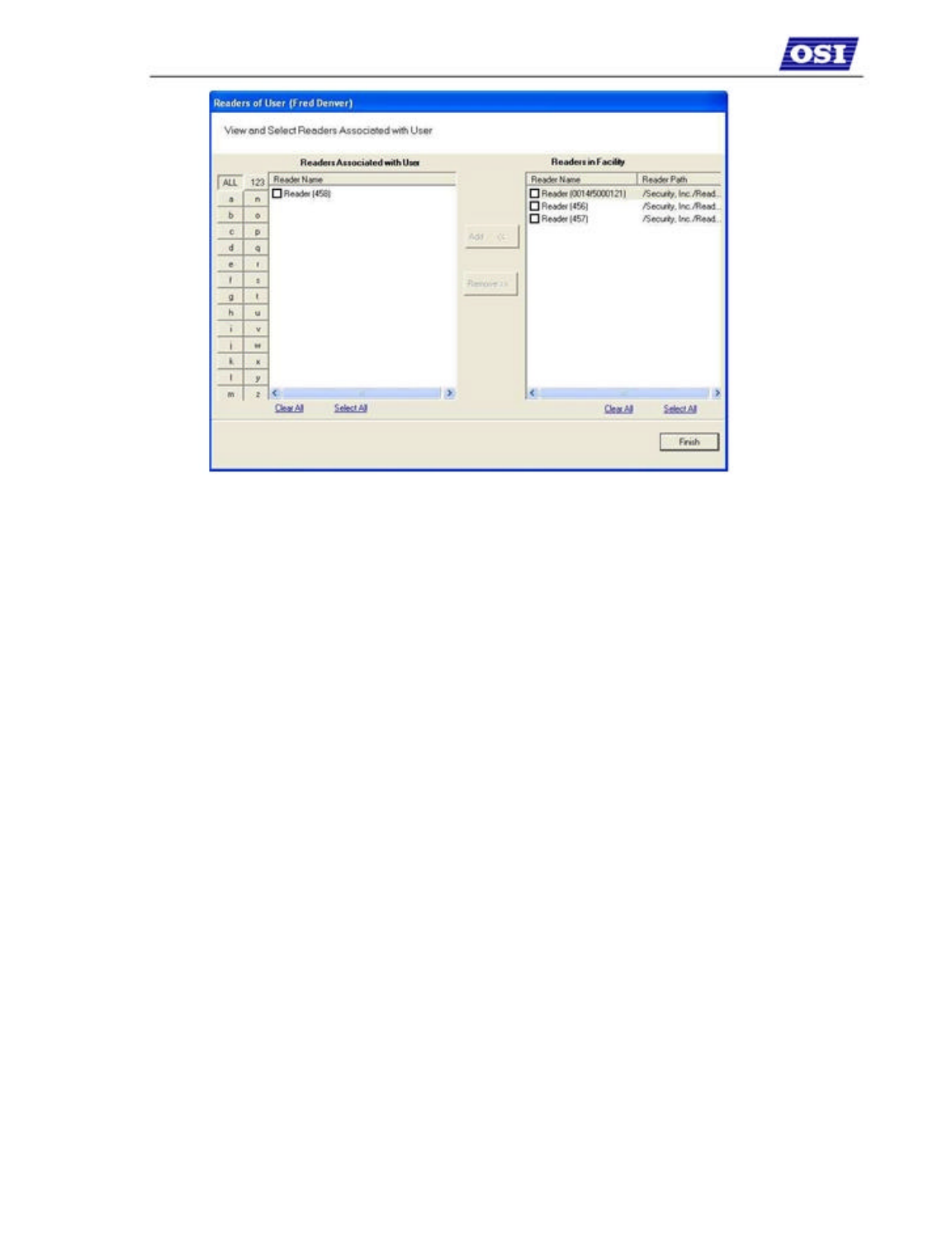
14 - USER’S GUIDE
3. Select the reader(s) from Readers in Facility.
4. Select Add <<. The selected readers are moved from the Readers in Facility list to the
Readers Associated with User list on the left. You can associate a user with any number
of readers.
5. Select Finish to save your settings and return to the Users Tab.
User Groups
If User Groups have been created for your facility, these will already be associated with readers.
For example, a User Group may have been defined for Laboratory Building 1. Laboratory
Building 1 might have six readers. By assigning the user to the Laboratory Building 1 Users Group,
they will automatically be associated with all the readers in that group.
A User Group may also be defined as a Timezone Group. Timezone User Groups further define
access levels for the Master Timezone. You can restrict access of certain groups of employees to a
specific time period. For example, you may have a housekeeping group designated as a Timezone
Group with restricted access to dormitories from 8:00 a.m. to 4:00 p.m., weekdays only. You would
then assign users from the housekeeping department to this group. For more information about
creating Timezone Groups, see the Administrator’s Guide. Steps to add users to User Groups are
presented in the following section.
To add a user to a User Group:
1. When adding or editing a User, in the Associations Category, click in the User Groups
field and click the ellipsis button. The User Groups of User dialog box opens.
WIRELESS ACCESS MANAGEMENT SYSTEM
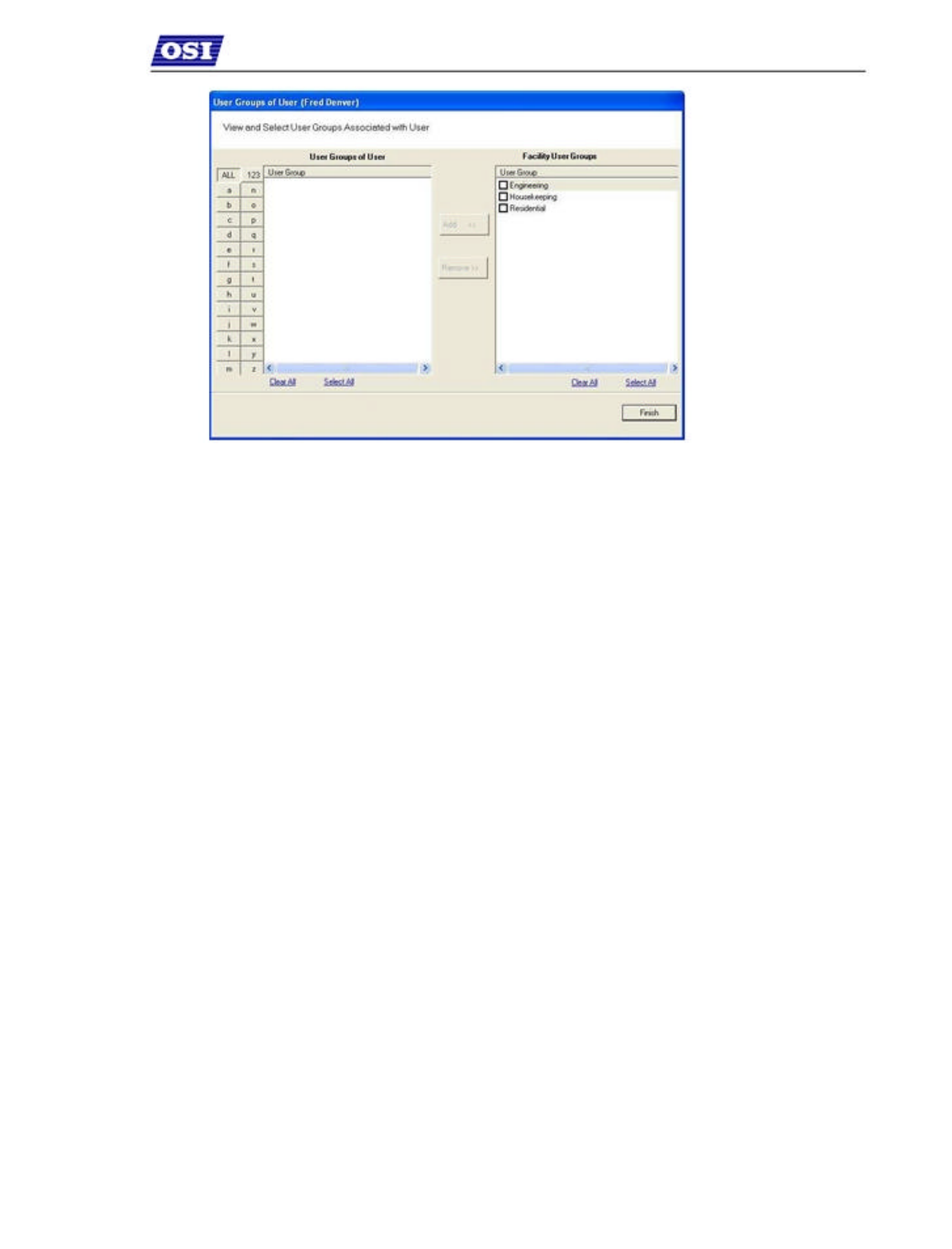
USER’S GUIDE- 15
2. Select the group(s) to associate with this user and click the Add << button. The groups
are added to the User of Groups list.
3. Select Finish to save your selections and return to the Users Tab. You can add or
change User Groups for a user any time by returning to this list.
NOTE: You can also add users to User Groups from the Facility Tab, User Groups field. For
more information about this feature, see Facility Associations, User Groups in the Administrators
Guide.
Credential Settings
WAMS tracks individual requests for access or exit from the facility by their unique credentials, and
each request is recorded as a transaction in the WAMS database for reference. Whether your
organization uses keypad readers or card readers, each user will be assigned a unique
credential number. Under Credential Settings, you will enter the credential ID and number, select a
credential type, and set additional parameters related to the credential type. You can add
another level of security by combining an individual’s credential with a personal ID number (PIN). If
your organization requires a PIN, you will enter them here.
Credential setup is a two-step process: First you will select the credential type to be used, then
you will register the credential
Keypad Type
The default credential type in WAMS is Keypad. When you add a user to the system, WAMS
assigns them a unique keypad credential number, then automatically registers it with the system. If
your facility uses only keypads, once you add the new user name, you can skip to Adding PINs and
Expirations Dates.
Card Types
If your facility uses card type credentials, you must select the card type, enter the appropriate
settings, and then register the credential number with the system.
WIRELESS ACCESS MANAGEMENT SYSTEM
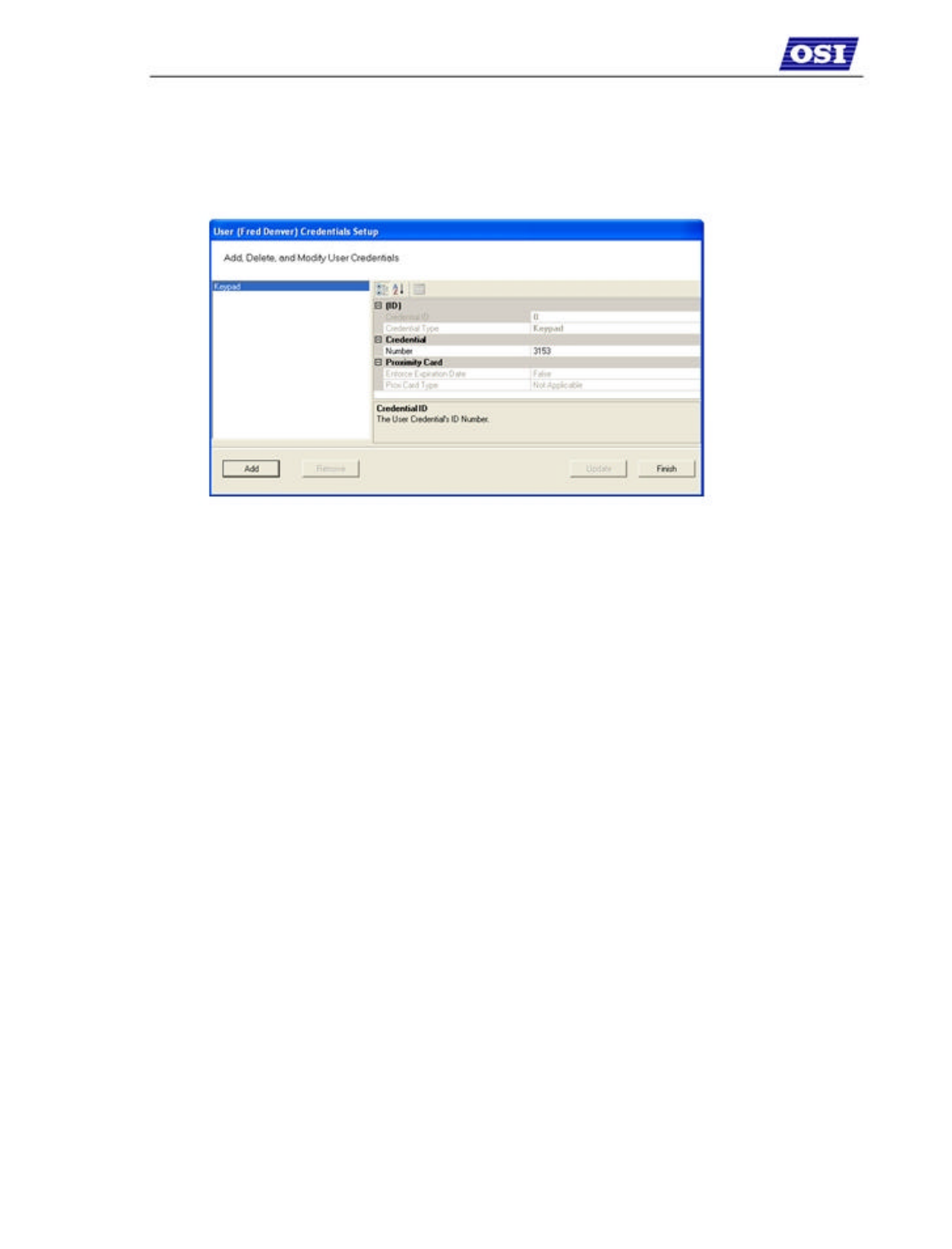
16 - USER’S GUIDE
To select the card type:
1. In the Users Tab, Credentials line, place the cursor next to (Collection) and select the
ellipsis button. The User Credentials Setup dialog box opens. The credential types are
listed on the left and the categories available for each type are listed on the right.
2. Select the type of credential the reader will use, for example, magnetic stripe card (Mag
Card). The credential options in the categories on the right will change, depending on the
type selected. Now you are ready to register the credential.
NOTE: If the credential type you need is not in the list of card types on the left, you can add one.
See Adding a Credential Type later in this section.
Credential De-Activation
You can define whether a user’s credentials can be automatically de-activated. This is useful, for
example, when entering credentials for a temporary employee or contractor. If the credential can be
de-activated, select True from the drop-down list next to the field, and then enter the de-
activation date in the De-Activation Date field. If the credential cannot be de-activated, select
False from the drop-down list. The default de-activation date is 200 years to ensure a user’s
credential is not inadvertently de-activated.
Registering the Credential
When you select a credential type, the Specify the Credential Number dialog box opens. From
here, you can enter the credential number manually, scan the user’s card with a scanning device
connected to your computer, or specify a reader where the user will scan their card. Steps to
register each type of card are presented in the next few sections.
NOTE: If you use the reader scan method, the card used must be unassigned.
You can have any one of the other types, or none.
WIRELESS ACCESS MANAGEMENT SYSTEM
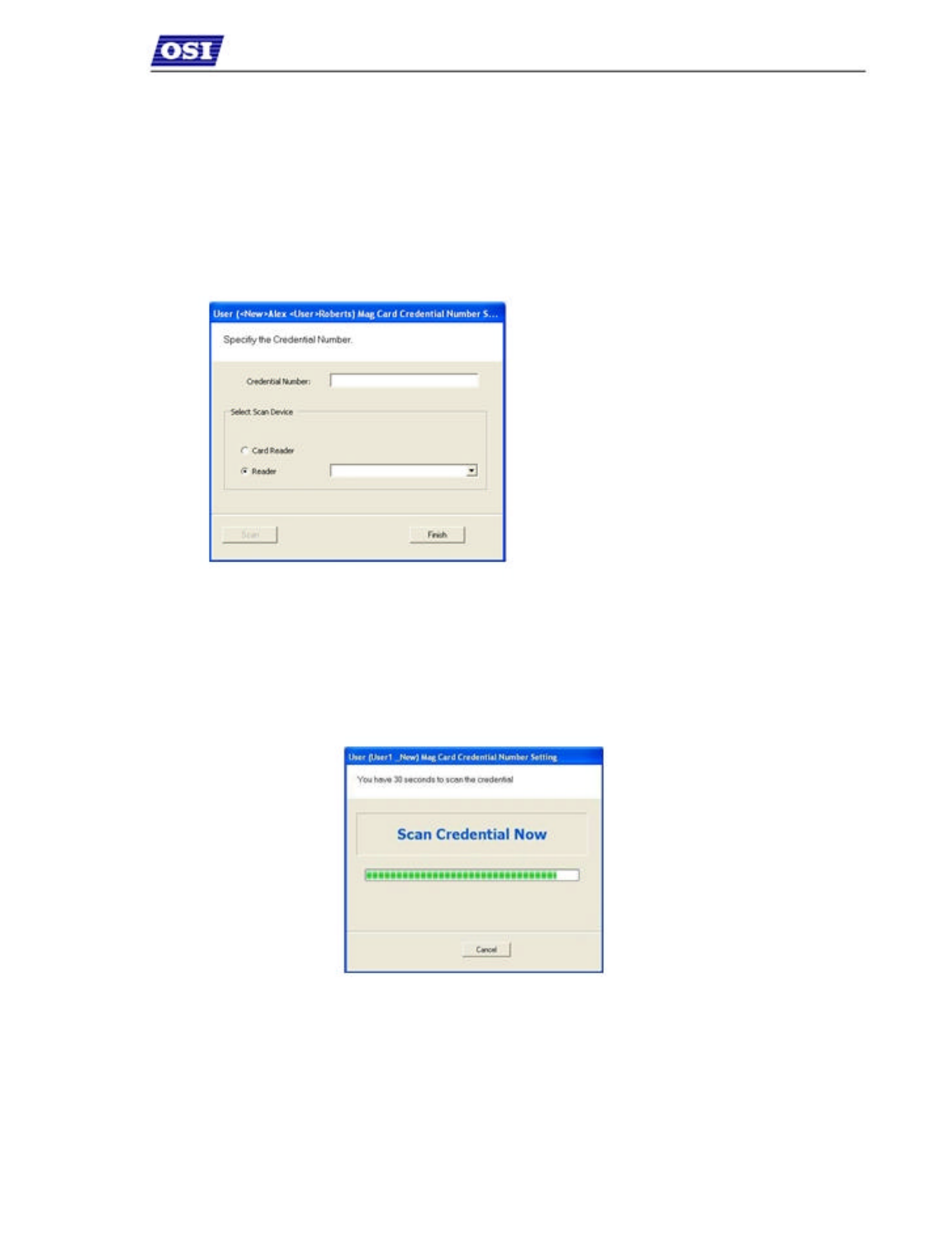
USER’S GUIDE- 17
To register a Keypad credential:
1. Keypad credentials are automatically registered by the system, and no further steps are
required.
To register a Magnetic Stripe Card credential:
1. From the User Credential Setup dialog box, select Mag Card from the list. The Users
Mag Card Credential Number dialog box opens.
2. Enter a Credential Number manually (must be less than 16 characters, zeros will be
prepended) or select a scan device:
Card Reader
_ If you have a scanning device connected to your computer, select
Card Reader. When you are ready to scan the card, select the Scan
button. You will have 30 seconds to scan the card.
When recognized, the number will display in the Credential Number text box.
Select Finish and return to the Credential Setup dialog box.
WIRELESS ACCESS MANAGEMENT SYSTEM